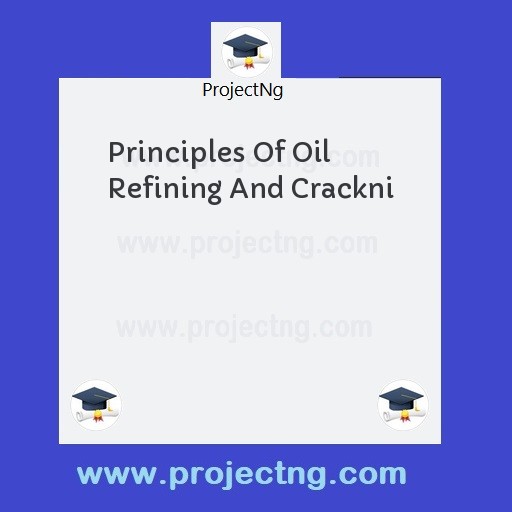Principles Of Oil Refining And Crackni
Science Lab Technology Project Topics
Get the Complete Project Materials Now! »
PRINCIPLES OF OIL REFINING AND CRACKNI
INTRODUCTION
Petroleum refining is the process of separating the many components present in crude petroleum. The separation of petroleum into fractions and treating of these fractions to yield marketable products. Petroleum is a mixture of gaseous, liquid and solid hydrocarbon compounds that occurs in sedimentary rock deposits throughout the world. In the crude state, petroleum has little value but when refined, it provides liquid fuels (gasoline, diesel fuel, aviation fuel), solvents, heating oil, lubricants, and the distillation residuum asphalt, which is used for highway surface and roofing materials[Laurence etal, 1989].
Petroleum refining begins with the distillation, or crude oils into separate hydrocarbon groups. The resultant products are directly related to the characteristics of the crude oil being processed. Most of these products of distillation are further converted into more useable products by changing their physical and molecular structures through cracking, reforming and other conversion processes. These products are subsequently subjected to various treatment and separation processes, such as extraction, hydotreating and sweeting, in order to produce finished products[Jacqueline et al].
7.1 Principle of refining Petroleum
The principle which is used is that the longer the carbon chain, the higher the temperature at which the compounds will boil. Petroleum processing and refining involves a series of steps by which the original crude oil is converted into products with desired qualities in the amounts dictated by the market. In fact, a refinery is essentially a group of manufacturing plants that vary in number with the variety of products in the mix. Refinery processes must be selected and products manufactured to give a balanced operation; that is, crude oil must be converted into products according to the demand for each[Sereda et al 2004].
For example, the manufacture of products from the lower-boiling portion of petroleum automatically produces a certain amount of higher-boiling components. If the latter cannot be sold as, say, heavy fuel oil, these products will accumulate until refinery storage fugitives are full. To prevent such a situation, the refinery must be flexible and able to change operations as needed. This usually means more processes, such as thermal processes to change excess heavy fuel distillation processes to separate heavy oil into lubricating oil socks and ashalt[James and Dggett, 2007].
7.2 Fractional Distillation/Fractionation
Definition: Fractional distillation is the process of separating the constituents of a liquid mixture by heating it and condensing separately the components according to the different boiling points.
In a distillation unit, a tower is used for fractionation. The feedstock of crude oil flows through one or more pipes arranged within a large furnace where it is heated to predetermined portion of the feed changes into vapour. The heated feed is introduced into a fractional distillation tower where the non volatile or liquid portions pass downward to the bottom of the tower and are pumped away, while the vapour pass upward through the tower and are fractionated into gas oils, kerosene, and naphthas[Wallace et al, 2005].
Vacuum distillation is used in petroleum refinery to separate the less volatile products such as lubricating oils, from petroleum without subjecting the high-boiling products to cracking conditions. Operating pressure for vacuum distillation is usually 50 – 100mm of mercury (6.7 – 13.3 kilopascals) (atmospheric pressure = 760mm of mercury). By this means, a heavy gas oil that has a boiling range in excess of 3150C (6000F) at atmospheric pressure may be obtained at temperature of around 1500C (3000F), lubricating oil, having a boiling range in excess of 3700C (7000F) at atmospheric pressure may be obtained at temperature of 250-3500C (480 – 6600F). atmospheric and vacuum distillation are major parts of refinery operations and no doubt will continue to be used as the primary refining operation[Michael and Jerry, 2007].
7.3 Structure of Fractionating Tower
The fractionating tower is a tall steel cylinder attached to an electrically heated furnace. Throughout the length of the tower, there are trays which raised holes covered with loose fitting caps allow the vapors to raise up and not down. The tower has outlet pipes at various levels along it’s length. The diagram below illustrates the fractional distillation of the crude oil and the temperature ranges in which the different hydrocarbon condenseRueping and Nachtsheim, 2010].
7.4 The Working Principle of Fractional Tower Including Main Towers, side Strippers and Special Towers
7.4.1 Main Towers
Here, the reaction product vapors flows from the top of the reactor to the bottom section of the distillation column (commonly referred to as the main fractionator or main tower), where they are distilled into fluid catalytic creating (FCC) end products of creaked naphtha, fuel oil and off gas. After farther processing for removal of sulfur compounds, the created naphtha becomes a high-actane component of the refinery’s blended gasolines [Asinger et al,1968].
Be the First to Share On Social

Enjoying our content?
Don't miss out on new videos! Subscribe to our YouTube channel for more awesome content.
Subscribe Now!













